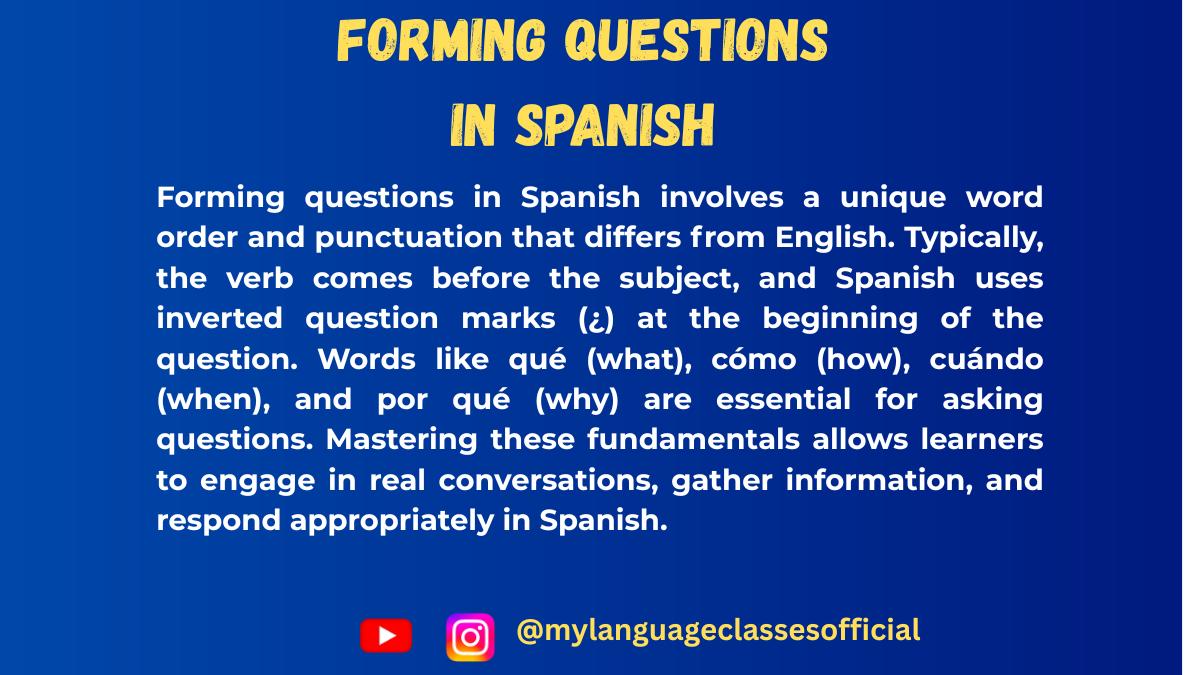Your cart is currently empty!
Forming Questions in Spanish

Forming Questions in Spanish
Forming questions in Spanish is essential for effective communication. Whether you’re asking for directions, ordering food, or getting to know someone, mastering this skill will help you express yourself confidently. In this post, we’ll explore the most common question words, how to structure questions, and important grammatical details to keep in mind.
Commonly Used Question Words in Spanish
Here’s a list of essential question words in Spanish, their meanings, and examples of usage:
- ¿Qué? – What?
- Example: ¿Qué quieres comer? (What do you want to eat?)
- ¿Quién? / ¿Quiénes? – Who?
- Example (singular): ¿Quién llamó? (Who called?)
- Example (plural): ¿Quiénes son tus amigos? (Who are your friends?)
- ¿Dónde? – Where?
- Example: ¿Dónde vives? (Where do you live?)
- ¿Cuándo? – When?
- Example: ¿Cuándo es la reunión? (When is the meeting?)
- ¿Por qué? – Why?
- Example: ¿Por qué estudias español? (Why are you studying Spanish?)
- ¿Cómo? – How?
- Example: ¿Cómo estás? (How are you?)
- ¿Cuál? / ¿Cuáles? – Which?
- Example (singular): ¿Cuál es tu color favorito? (Which is your favorite color?)
- Example (plural): ¿Cuáles son tus libros? (Which ones are your books?)
- ¿Cuánto? / ¿Cuánta? / ¿Cuántos? / ¿Cuántas? – How much? / How many?
- Example (masculine singular): ¿Cuánto cuesta? (How much does it cost?)
- Example (feminine singular): ¿Cuánta agua necesitas? (How much water do you need?)
- Example (masculine plural): ¿Cuántos días quedan? (How many days are left?)
- Example (feminine plural): ¿Cuántas personas hay? (How many people are there?)
- ¿Para qué? – What for?
- Example: ¿Para qué sirve esto? (What is this for?)
- ¿De quién? / ¿De quiénes? – Whose?
- Example (singular): ¿De quién es este libro? (Whose book is this?)
- Example (plural): ¿De quiénes son estas mochilas? (Whose backpacks are these?)
Key Grammar Points to Remember
- Inverted Question Marks:
Always start your questions with an inverted question mark (¿) in Spanish.
Example: ¿Cómo te llamas? (What is your name?) - Gender and Number Agreement:
- Question words like cuánto, cuánta, cuántos, and cuántas must agree in gender and number with the noun they refer to.
- Masculine singular: ¿Cuánto dinero tienes? (How much money do you have?)
- Feminine plural: ¿Cuántas flores hay en el jardín? (How many flowers are in the garden?)
- Question words like cuánto, cuánta, cuántos, and cuántas must agree in gender and number with the noun they refer to.
- Verb Placement:
In Spanish, the verb typically follows the question word:- Example: ¿Qué haces? (What are you doing?)
- Articles with Nouns:
When a question involves a noun, the correct article must be used to agree with the gender and number:- Example: ¿Qué opinas del libro? (What do you think about the book?)
- Direct and Indirect Questions:
Direct questions use the question word, while indirect ones introduce the question word within a statement:- Direct: ¿Dónde está la estación? (Where is the station?)
- Indirect: No sé dónde está la estación. (I don’t know where the station is.)
- Intonation in Yes/No Questions:
For yes/no questions, intonation can replace question words.- Statement: Tú vienes mañana. (You are coming tomorrow.)
- Question: ¿Tú vienes mañana? (Are you coming tomorrow?)
Things to Keep in Mind
- Politeness: Use polite structures when needed, like adding por favor (please) or using formal pronouns (usted).
- Example: ¿Podría decirme dónde está el baño? (Could you tell me where the bathroom is?)
- Regional Variations:
Some question structures and vocabulary may vary between Spanish-speaking countries. For instance:- Spain: ¿Cómo te llamas? (What is your name?)
- Mexico: ¿Cuál es tu nombre? (What is your name?)
- Practice Contextual Use:
Try forming questions based on real-life situations, such as asking for directions:- ¿Dónde está el mercado? (Where is the market?)
Practice Exercise
Translate these English questions into Spanish:
- What time is it?
- Where are you from?
- Who is coming to the party?
- How much does it cost?
- Why are you late?
Check your answers and practice saying them aloud to improve your fluency.
By understanding these basics and practicing consistently, you’ll soon master the art of forming questions in Spanish. ¡Buena suerte! (Good luck!)
If you found this guide helpful, I’d love to hear from you! Share your thoughts in the comments below or connect with me on social media. For more tips, resources, and inspiration, visit my blog at mylanguageclasses.in. Follow on Instagram and subscribe on YouTube
📚 Continue Learning Spanish
Vikas Kumar is a dedicated language educator, content creator, and digital entrepreneur, best known as the co-founder of My Language Classes and The Curious Mind. With a strong focus on helping learners achieve fluency in English, Spanish, and Japanese, he has guided audiences worldwide through a diverse range of resources, including in-depth blog articles, engaging YouTube tutorials, and comprehensive Books.
Through My Language Classes, Vikas has built a thriving multilingual learning platform that serves students, travelers, and professionals eager to master communication skills for personal, academic, and professional success. His expertise extends to exam preparation for internationally recognized certifications such as JLPT, DELE, IELTS, and TOEFL, enabling learners to achieve tangible, career-enhancing results.
As the founder of The Curious Mind, he also explores broader areas of knowledge, including self-help, motivation, modern learning strategies, and thought-provoking insights on life and personal growth. His work blends practical teaching methods with a deep understanding of learner psychology, making complex concepts accessible and engaging.
Driven by a mission to make high-quality education accessible to all, Vikas continues to expand his reach across multiple platforms, including YouTube, blogs, eBooks, and social media communities, inspiring thousands to learn, grow, and embrace lifelong learning.


Leave a Reply